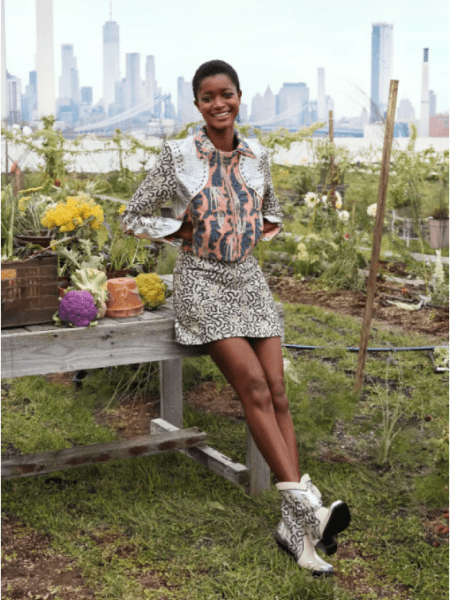The fashion industry can learn a lot from nature, and history has proven that many human inventions have come from replicating what nature has done. The possibilities are immense, from creating an airplane in the shape of a bird to fabrics being produced from mushrooms.
Over the past decade, the fashion industry has made significant progress in biomimicry. By developing products made of bio-based materials that are both anti-bacterial and biodegradable, we are moving closer to a circular fashion industry. Some well-known brands that are already involved in this research and development include H&M, Stella McCartney, Salvatore Ferragamo, and more. In this article, I’ll share some of the different bio-based material innovations, such as those made of fruit, food waste, mycelium, and even jellyfish!
Fruit
Who would have thought that one day you could be wearing clothes made from the fruit you eat? Consider the texture and durability of a fruit’s outer layer next time you go grocery shopping. The more notable ones that have made their place in the fashion industry today are pineapples and oranges.
Piñatex®
Created by the innovators at Ananas Anam,  led by Dr. Carmen Hijosa, Piñatex was developed out of the mission to find sustainable and safe leather alternatives. Their process works by using the by-products of pineapple harvest to create a non-woven material. This means that no additional environmental resources are required for its production – truly exemplifying what a circular business practice looks like.
led by Dr. Carmen Hijosa, Piñatex was developed out of the mission to find sustainable and safe leather alternatives. Their process works by using the by-products of pineapple harvest to create a non-woven material. This means that no additional environmental resources are required for its production – truly exemplifying what a circular business practice looks like.
By avoiding the likes of PVC and genuine leather production, Piñatex has gained much traction over the years. In 2019, H&M partnered with Ananas Anam to create a conscious collection including a Piñatex leather jacket as shown here.
Orange Fiber
Ever imagined that a silk-like fabric could be made from oranges? Well, the company Orange Fiber has made this a reality. After learning that over 700,000 tons of citrus juice by-products were disposed of each year in Italy alone, the founders, Adriana Santanocito and Enrica Arena worked to solve this problem and create something beautiful in the process.

So how does it work? Their technology extracts high-quality cellulose from the citrus juice industry’s leftovers (pulp and peels) and converts it into fibers. Once the fibers are made, they are then spun into a biodegradable yarn and woven into a fabric with a silk-like texture and look.
Orange Fiber has collaborated with brands like H&M, Salvatore Ferragamo, and E. Marinella, along with other notable partners like the Lenzing Group, with whom they produced the first TENCEL™ branded lyocell fiber made of orange pulp and wood sources. This product, along with their original Orange Fiber fabric, offers a closed loop process, demonstrating what a circular fashion system can look like.
Food Waste
 The Toronto-based startup, ALT TEX, is working on developing a waste-to-wardrobe technology that will produce a polyester-like textile. This new material will not only help with emissions caused by compost waste, but it will also be biodegradable and carbon neutral. The technology works by re-engineering sugars extracted from food waste into polyester-like bio fibers, which can then be spun into threads and woven into a textile. They are also working on non-woven textiles for different types of apparel, which we should be learning about more in the near future.
The Toronto-based startup, ALT TEX, is working on developing a waste-to-wardrobe technology that will produce a polyester-like textile. This new material will not only help with emissions caused by compost waste, but it will also be biodegradable and carbon neutral. The technology works by re-engineering sugars extracted from food waste into polyester-like bio fibers, which can then be spun into threads and woven into a textile. They are also working on non-woven textiles for different types of apparel, which we should be learning about more in the near future.
Short for “Alternative Textiles,” ALT TEX’s co-founders Myra Arshad and Avneet Ghotra (pictured here) have raised seed funding of $1.5 million CAD in 2021 to help scale their production. The duo is truly taking on a challenge that could make a big difference in sustainable fashion. We will certainly be hearing more about them in the years to come!
Fungi
Dubbed as the “new plastic” by many,  mycelium is the root-like structure that makes up fungi, such as mushrooms. Not only is the growth of fungal materials easy to produce, with little energy required, but it can also grow into any desired shape and size. If this process is advanced and scaled, it will provide the fashion industry with a unique raw material that is sustainable and not made of cellulose. Due to its biodegradability, mycelium makes a great vegan leather substitute for plastic.
mycelium is the root-like structure that makes up fungi, such as mushrooms. Not only is the growth of fungal materials easy to produce, with little energy required, but it can also grow into any desired shape and size. If this process is advanced and scaled, it will provide the fashion industry with a unique raw material that is sustainable and not made of cellulose. Due to its biodegradability, mycelium makes a great vegan leather substitute for plastic.
However, some of the challenges with producing mycelium products include improving the strength and durability of the material as well as finding a way to wash it while maintaining its integrity. Within the next decade, we should be seeing more mycelium leather items available as many researchers are working to scale up this production process. A brand that has already produced mycelium-leather products is Stella McCartney, who collaborated with Bolt Threads to create The Frayme Mylo™️ Bag. Another great company that is doing research and development to make mycelium mainstream is Mylium, based in the Netherlands.
Jellyfish
Another bio-based material that is in the early stages is jellyfish. You may be wondering how a live animal could be a sustainable alternative to conventional materials. Well, the simple answer is that there is a large amount of jellyfish washing up to shores all around the world—so researchers thought, “How can we turn this problem into an opportunity?” According to researchers at ArtEZ University, led by Dr. Jeroen van den Eijnde, the raw material derived from jellyfish waste is actually very sustainable and high-quality. It can also retain its unique elasticity and flexibility after going through a special natural treatment described as washing, salting, drying, and pressing. Although it is not mainstream as of now, jellyfish material could be a great leather alternative in the future. VEGEA, a Milan-based company that focuses on developing sustainable biomaterials for fashion, furniture, and packaging, is also working towards making jellyfish a mainstream raw material.
As the fashion industry slowly makes the shift away from the take-make-waste approach, it’s (re)turning to nature for inspiration to help it become more sustainable. There are so many breakthrough materials coming to the market. Stay tuned for future blogs as we continue to watch this space grow!
—
Biomaterials:
Science, Innovation & Design
—
Fashion Takes Action is excited to be hosting a panel on Biomaterials: Science, Innovation & Design at its 2022 WEAR Conference taking place from October 6-7 in Toronto. We’ll be talking about how the fashion industry can tackle its reliance on fossil fuels by replacing resource-intensive and environmentally-destructive materials with natural, plant-based materials – without sacrificing quality or durability. We’ll be joined by Jason Robinson, Founder of Evoco, a material innovation company harnessing the power of nature through plant-based chemistry to develop the next generation of high-performing, sustainable products.
One of Evoco’s key products is FATESTM, a high-performing, plant-derived eco-foam currently used for athletic goods and insole and midsoles in footwear brands including Kodiak, Timberland, and Vans to name a few, that uses 70-80% bio-content. FATES® creates up to 70% less CO2 than the industry standard polyurethane foam and does not use tin or other heavy metal pollutants as catalysts. Using the power of plants (industrial corn – corn not meant for food consumption and agricultural waste), Evoco’s innovative research and development team has turned plants into patented green chemistry that makes functional high performing products.

Written by: Alexandra Petros
